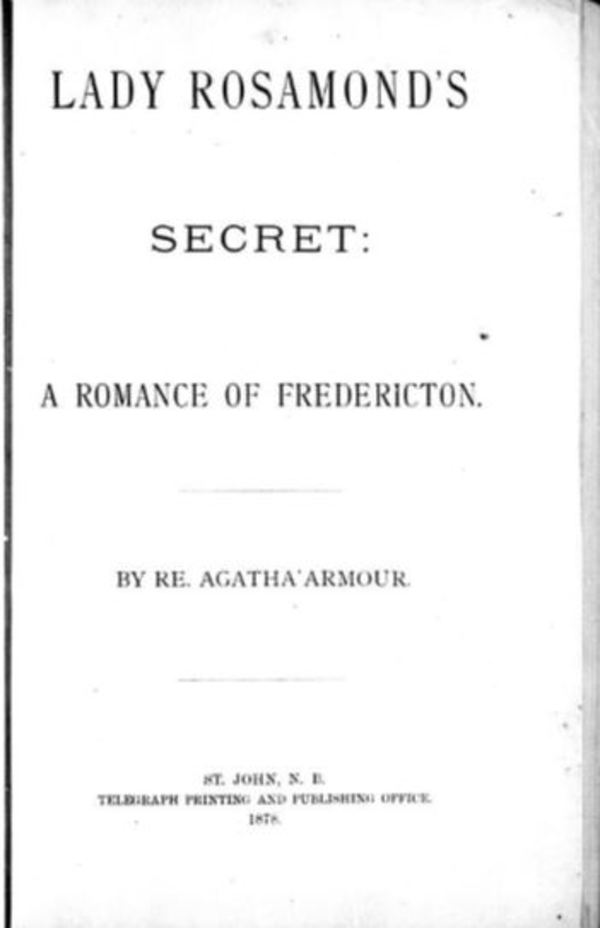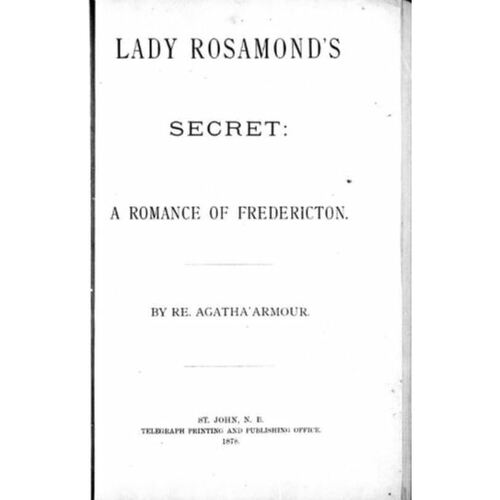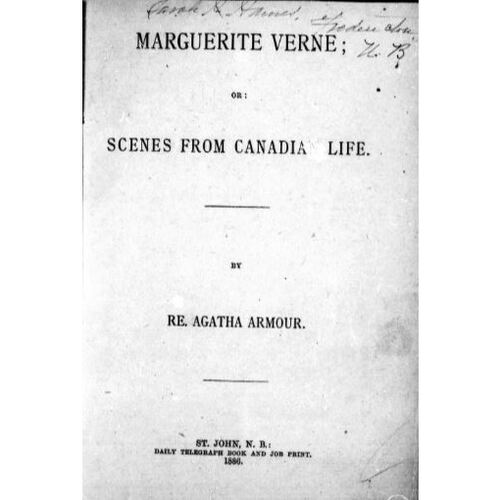
Source: Link
ARMOUR, REBECCA AGATHA (Thompson), teacher and author; b. 25 Oct. 1845 in Fredericton, eldest daughter of Joseph Armour and Margaret Hazlett; m. there 22 Jan. 1885 John G. Thompson; they had no children; d. there 24 April 1891.
Rebecca Agatha Armour’s father emigrated from Coleraine (Northern Ireland) in 1820, and described himself variously in Fredericton as a merchant and a grocer. Rebecca attended St Paul’s Church with her Irish-born Presbyterian parents and, after graduating from the Provincial Teachers’ College, received her licence to teach on 30 Nov. 1863. She pursued her profession in Fredericton for a number of years and was later described as having been “one of the best lady teachers in the service in New Brunswick.”
On 1 May 1873 Armour’s teaching licence was transferred to southern New Brunswick, and she probably moved to Lancaster (Saint John West) at this time. According to the Saint John Daily Telegraph in November 1878, it was in Lancaster that she composed “stories, which were very cleverly written, [and] attracted a great deal of attention, and the newspapers which contained them were in great demand.” However, she was back in Fredericton at the end of that month when the Daily Telegraph published, by subscription, her novel Lady Rosamond’s secret: a romance of Fredericton.
Costing 50 cents or $5.00 for twelve copies, this first novel was set in England and Fredericton during the years 1824–31, the period of Sir Howard Douglas*’s lieutenant governorship of New Brunswick. Suffering from stilted dialogue, self-conscious authorial intrusions, and sycophantic praise of Sir Howard, Lady Rosamond’s secret none the less provides interesting glimpses of Fredericton in the 1820s. Armour alludes to skating parties, military races, the Philharmonic Society, and the St Patrick’s Society as threads in the social fabric of the capital, and she makes the agricultural state of the province, the Miramichi fire, the rebuilding of Government House, the opening of King’s College, and the Maine boundary question all part of the historical background of the work. Her interest in local buildings was further developed in her series on “Old landmarks of Fredericton,” which appeared in the Fredericton Capital in 1880. Writing to Saint John historian Joseph Wilson Lawrence on 1 Sept. 1880 for information on Rose Hall in Fredericton, the former home of Benedict Arnold*, she expressed her frustration in finding the evidence needed for her work: “I have interviewed many of the old families but strange to say there is not a record of any historical value in the city of Fredericton.” Lawrence’s response was evidently prompt, for her essay on Rose Hall appeared in the Capital on 23 September. By 27 November she had published at least seven more sketches, colouring them with anecdotes and the occasional personal opinion.
On 22 Jan. 1885 Armour married John G. Thompson, a Fredericton carriage maker who followed the trade of his Irish Presbyterian father. She continued to write: by 19 Oct. 1886 the Daily Telegraph was advertising Marguerite Verne; or: scenes from Canadian life, a new novel sold by subscription for 50 cents a copy. Set in Saint John in the mid 1880s, the story revolves around the troubled courtship of a local lawyer and the heroine of the title. The novel is marred by abrupt transitions, authorial asides, heavy-handed moralism, and convenient coincidences, but is of interest for its allusions to Saint John business life, the rebellion led by Louis Riel*, colonials in London, and familiar New Brunswick landmarks. At least two other novels, Marion Wilburn (n.d.) and Sylvia Leigh; or, the heiress of Glenmarle (1880), were published in Saint John during Armour’s lifetime.
Rebecca died in 1891 within three weeks of her mother. Her estate was contested by one of her sisters, for a will made by Mrs Armour just three days before her own death had left everything to Rebecca and John Thompson. Rebecca’s passing was therefore surrounded with the kind of human drama that she relished in her fiction. The place of that fiction in Canadian literature was not to be a lasting one, but in her own time her novels fostered pride of place and loyalty to the imperial connection, a characteristic of much post-confederation writing. As she wrote in Marguerite Verne: “We have liberty, right, education, refinement and culture in our midst; we have a good government, noble reforms, and all advantages to make us good and happy. Then let us cherish every right and institution which makes our beloved New Brunswick the pride of its loyal people. It is such feeling which prompts this work, and if the different scenes throughout the province which we will endeavour to portray, the usages of society, custom, &c., and the few characters introduced from real life, meet your approbation, our highest expectation will be realized.”
[No copies of Armour’s novels Marion Wilburn and Sylvia Leigh appear to be extant. Eight articles in the series “Old landmarks of Fredericton” were published anonymously in the Fredericton Capital between September and November 1880: “. . . Rose Hall” (23 Sept.); “. . . The Hermitage” (2 Oct.); “. . . Waterloo Row” (16 Oct.); “. . . The Golden Ball, Waterloo Row” (23 Oct.); “. . . Royal Oak, Waterloo Row” (30 Oct.); a sketch entitled “Leading establishments half a century ago” (13 Nov.); and two articles simply called “Old landmarks of Fredericton” (20, 27 Nov.). The surviving run of the Capital for this period is incomplete, and it is possible that Armour published more than these eight sketches; however, I could find no evidence to substantiate the claim in V. B. Rhodenizer, Canadian literature in English ([Montreal], 1965), 711, that she contributed about 50 instalments to the paper.
It should be noted that, although Armour was known as Rebecca to family and friends, she signed her novels Re. Agatha Armour. g.d.]. NA, MG 23, D1, ser.1, 80: 341–43. PANB, RG 7, RS75, 1891, Margaret Armour; RG 11, RS115, 13/8: 6; St Paul’s United Church (Fredericton), records of Old St Paul’s Kirk [St Paul’s Church of Scotland], 3 Sept. 1843, 26 Nov. 1845, 1 Sept. 1870, 22 Jan. 1885 (mfm.). The Fredericton census of 1871, ed. R. F. Fellows (Fredericton, 1974), 12. The New Brunswick census of 1851: York County, comp. Elizabeth Sewell and Elizabeth Saunders (Fredericton, 1979). Butler’s Journal (Fredericton), May 1891. Daily Telegraph (Saint John, N.B.), 4, 29 Nov. 1878; 19 Oct. 1886. St. John Daily Sun, 25 April 1891. Hill, Old Burying Ground. Waiters, Checklist of Canadian literature (1972).
Cite This Article
Gwendolyn Davies, “ARMOUR, REBECCA AGATHA (Thompson),” in Dictionary of Canadian Biography, vol. 12, University of Toronto/Université Laval, 2003–, accessed December 31, 2025, https://www.biographi.ca/en/bio/armour_rebecca_agatha_12E.html.
The citation above shows the format for footnotes and endnotes according to the Chicago manual of style (16th edition). Information to be used in other citation formats:
| Permalink: | https://www.biographi.ca/en/bio/armour_rebecca_agatha_12E.html |
| Author of Article: | Gwendolyn Davies |
| Title of Article: | ARMOUR, REBECCA AGATHA (Thompson) |
| Publication Name: | Dictionary of Canadian Biography, vol. 12 |
| Publisher: | University of Toronto/Université Laval |
| Year of publication: | 1990 |
| Year of revision: | 1990 |
| Access Date: | December 31, 2025 |




